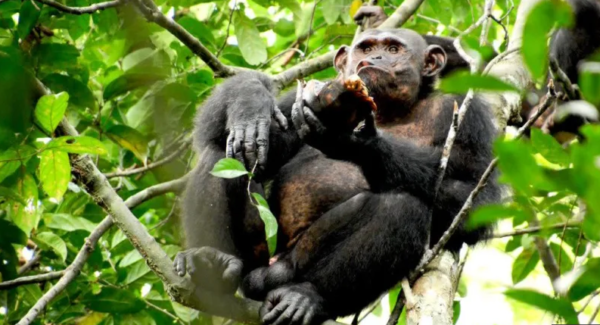

Chimp with tortoise. Image: Nadia Balduccio
The lead authors of the new study, Simone Pika from the University of Osnabrück and Tobias Deschner from the Max Planck Institute for Evolutionary Anthropology, described this shell-smashing behavior as “percussive technology.”
 Chimps eat a surprising variety of prey, including several species of monkeys (even baboons), red duikers (a small antelope), bushpigs, and various rodents. We can now add reptiles to the list, namely hinge-back tortoises (Kinixys erosa).
Chimps eat a surprising variety of prey, including several species of monkeys (even baboons), red duikers (a small antelope), bushpigs, and various rodents. We can now add reptiles to the list, namely hinge-back tortoises (Kinixys erosa).As to why tortoise-eating has only been seen in the Rekambo population and not others is another mystery to be solved. That said, the behavior appears to be cultural (as opposed to instinctual), with the chimps learning from each other and retaining the practice over time.
“It is too early to claim this, but the fact that tortoises exist at several other field sites where chimpanzees have been observed for decades and predation on them has never been observed is a first hint that indeed this might be a cultural trait,” explained Deschner in an email to Gizmodo. “To prove that social learning is the source of [cultural] transmission is difficult to show, but again, given the absence of this behavior in other populations suggests that most probably, this behavior was once invented by one individual in this population and then spread via observation and copying of the behavior, which is social learning.”
In total, 10 different chimps were seen consuming tortoise meat: seven adult males, one adult female, one adolescent male, and one adolescent female. Of the 38 predation events observed, 34 were successful (a failed attempt was an inability to access tortoise meat). The majority of the male population engaged in this dietary practice, making it a normal or “customary” behavior in the words of the researchers.
Here’s what a typical feeding session looked like. After a chimp discovered and captured a tortoise, it repeatedly smashed its plastron, or shell, against a tree trunk. The chimp then climbed up into a tree to consume the meat.
First, the “percussive technology,” in which the tree trunk was used as an anvil, can be construed a precursor to tool use in primates. This behavior, therefore, may be a glimpse into our ancient past.
Second, some chimps weren’t strong enough to break open the shells with their hands, so they handed the tortoises over to a stronger male. Remarkably, the male smashed the shells and willingly shared the meat with others. In total, 23 of the 38 events involved sharing of some sort. This prosocial behavior demonstrates the emotional complexity of chimps, and possibly even the consideration of needs of others. That said, Deschner said that sharing doesn’t necessarily tell us anything interesting about the social intelligence of animals, but rather the quality of their social relationships.
“Although we still have not enough detailed data to analyze the sharing patterns in detail, it seems that the Loango chimpanzees share tortoise meat very frequently and without harassment,” Deschner said, “indicating that high-ranking individuals do not use their force to acquire the meat via aggression and that the possibility exists that meat is exchanged for other services, [such as] grooming, [and] support in conflicts with other group members.”
Finally, one male was observed to store his food—a behavior typically ascribed to early hominins. This male, after eating about half of the tortoise meat, hid the remainder into the fork of a tree. The chimp then relocated to a different tree where he built a nest and called it a night. The next day he returned to the tree to retrieve and consume the remaining parts of the tortoise. This behavior certainly appears like foresight, in which the chimpanzee established conditions in the present to help out his future self. As the authors noted in the study, this cognitive trait may have emerged in early primates prior to the evolutionary split of hominin and chimpanzee ancestors.
For Deschner, this finding was of special importance because it highlighted a previously unknown behavior in a chimpanzee population that’s located quite far from any other group of well-studied chimps.
“We always find new behaviors—some of them cultural ones—that have never been observed before,” Deschner told Gizmodo. “This means though that when we lose chimpanzee populations due to habitat destruction and poaching, we do not only lose a number of individuals that might later on be replaced again, but we lose unique cultures which will be lost forever, and by this we close one window after the other that would allow us to study aspects of our own evolution.”
more recommended stories
 Fentanyl Seizures at Border Continue to Spike, Making San Diego a National Epicenter for Fentanyl Trafficking
Fentanyl Seizures at Border Continue to Spike, Making San Diego a National Epicenter for Fentanyl TraffickingFentanyl Seizures at Border Continue to.
 Utah Man Sentenced for Hate Crime Attack of Three Men
Utah Man Sentenced for Hate Crime Attack of Three MenTuesday, August 8, 2023 A.
 Green Energy Company Biden Hosted At White House Files For Bankruptcy
Green Energy Company Biden Hosted At White House Files For BankruptcyAug 7 (Reuters) – Electric-vehicle parts.
 Former ABC News Reporter Who “Debunked” Pizzagate Pleads Guilty of Possessing Child pδrn
Former ABC News Reporter Who “Debunked” Pizzagate Pleads Guilty of Possessing Child pδrnFriday, July 21, 2023 A former.
 Six Harvard Medical School and an Arkansas mortuary Charged With Trafficking In Stolen Human Remains
Six Harvard Medical School and an Arkansas mortuary Charged With Trafficking In Stolen Human RemainsSCRANTON – The United States.
 Over 300 People Facing Federal Charges For Crimes Committed During Nationwide Demonstrations
Over 300 People Facing Federal Charges For Crimes Committed During Nationwide DemonstrationsThe Department of Justice announced that.
